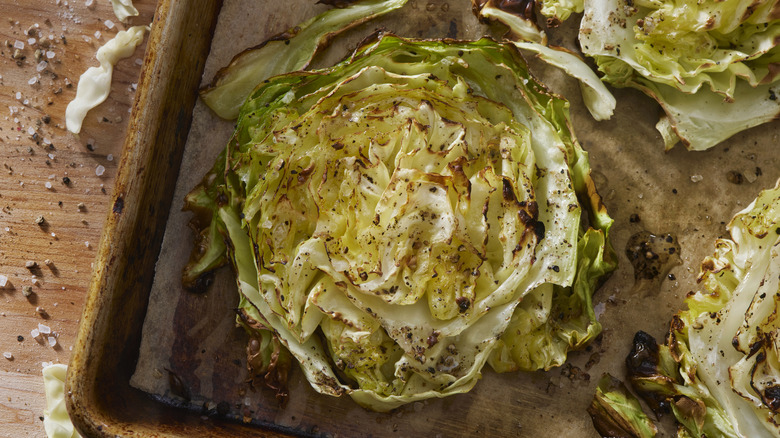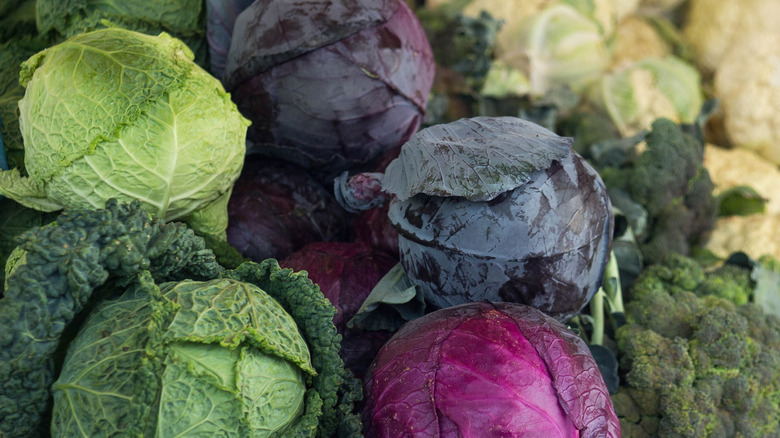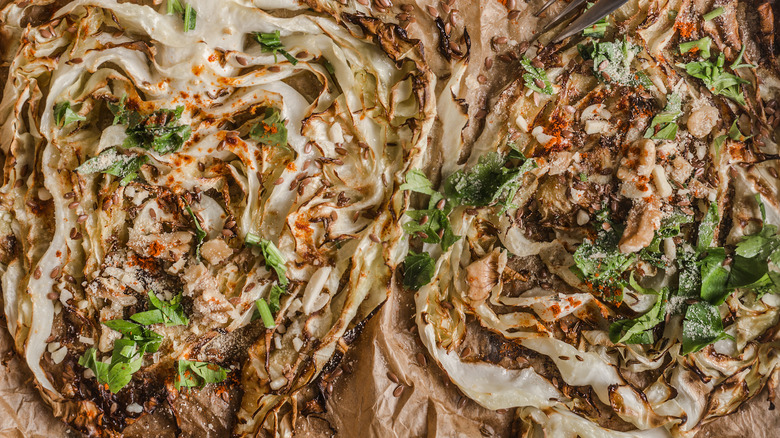The Best Way To Cut And Cook Cabbage Steaks
Cabbage steaks, the savory warmed-up relative of the wedge salad, are thick-cut discs of cabbage taken from the center of the vegetable. Many cabbage steak recipes call for relatively quick roasting times to preserve the integrity of the steak and ensure that every part, from the thin outer leaves to the crunchy core, maintains a juicy, flavor-filled consistency. Compared to many recipes for collard greens — another member of the cabbage family — cabbage steaks are a highly unique leafy green dish. It's this uniqueness that draws so many people to it.
Cooks use the center, rather than the ends, of a cabbage for cabbage steaks because it contains a reliable ratio of the vegetable's many layers. The top half of a cabbage consists mostly of delicate leaves that will quickly char under roasting. The bottom half is mostly stem and core, requiring a longer cooking time better suited for stews, soups, and broths.
But the center cuts of a cabbage consist of a leafy outer shell surrounding a firm core. After roasting, grilling, or pan-frying with oil and seasoning, this transforms the cabbage steak into a tender, flavor-filled heart surrounded by lightly charred, crispy leaves. Similar to a beef steak, a cabbage steak prepared with these instructions will be more well-done on its outer edges and become increasingly "rare" toward the center.
How to cut cabbage steaks
First, select a firm, compact cabbage like green, white, or Chinese cabbage. The cabbage family is broad, but vegetables like Savoy cabbage don't crisp up well under a roaster, and napa cabbage is far too loose and will fall apart while you prep it. Whether it's cabbage steaks or coleslaw, the first mistake people make when cooking with cabbage is picking the wrong kind.
Once you have your cabbage, remove the outer leaves and trim back the stem. Lay the cabbage on its side and remove the first couple of inches from each end. You should be left with a thick disc of cabbage that is flat on both ends.
Take this disc and cut it to your size preference, but keep in mind that how thick you want your cabbage steak depends on how crispy you want your edges while maintaining a tender, juicy core. Thicker-cut steaks require more time for the middle to soften, so the edges will crisp up significantly more than thin-cut steaks. For crisp, slightly blackened edges with a tender core, you want each steak to be roughly one inch thick.
How to cook cabbage steaks
Whether you're using a pan, roasting tray, or grill, cabbage steaks are best prepared using moderate heat and cooking times. In the oven at 400 degrees Fahrenheit, 20 minutes yields a steak with browned edges and a firm, juicy core. If you're looking for crisp, burnt edges with a soft core, aim for closer to 30 minutes or cooking at a higher temperature.
In a pan or over a grill, six to eight minutes per side is plenty of time to crisp up the cabbage steak and tenderize the center. Keep in mind that a grill's direct heat is well-suited for burnt edges, while a pan's even temperature is ideal for uniform browning on each flat side of a cabbage steak.
Cabbage naturally has a mild flavor and is well-suited for a broad variety of seasonings. As moisture leaves the cabbage leaves, they absorb other liquids like oil, vinegar, red or green pepper hot sauce, wine, or even meat juices — and with the variety of heat applications possible for cabbage steaks, you can customize herbs and spices to your palate.
For something savory, focus on oil, herbs, and garlic. Oil helps the cabbage crisp up in the oven and absorbs into the leaves, giving off a richer taste. If you want something sharper, however, consider sprinkling some balsamic vinegar over the cabbage steaks during the last few minutes of their cooking time. Balsamic is a highly versatile acid, great for greens, pork, dessert, and fruit in equal measure.



